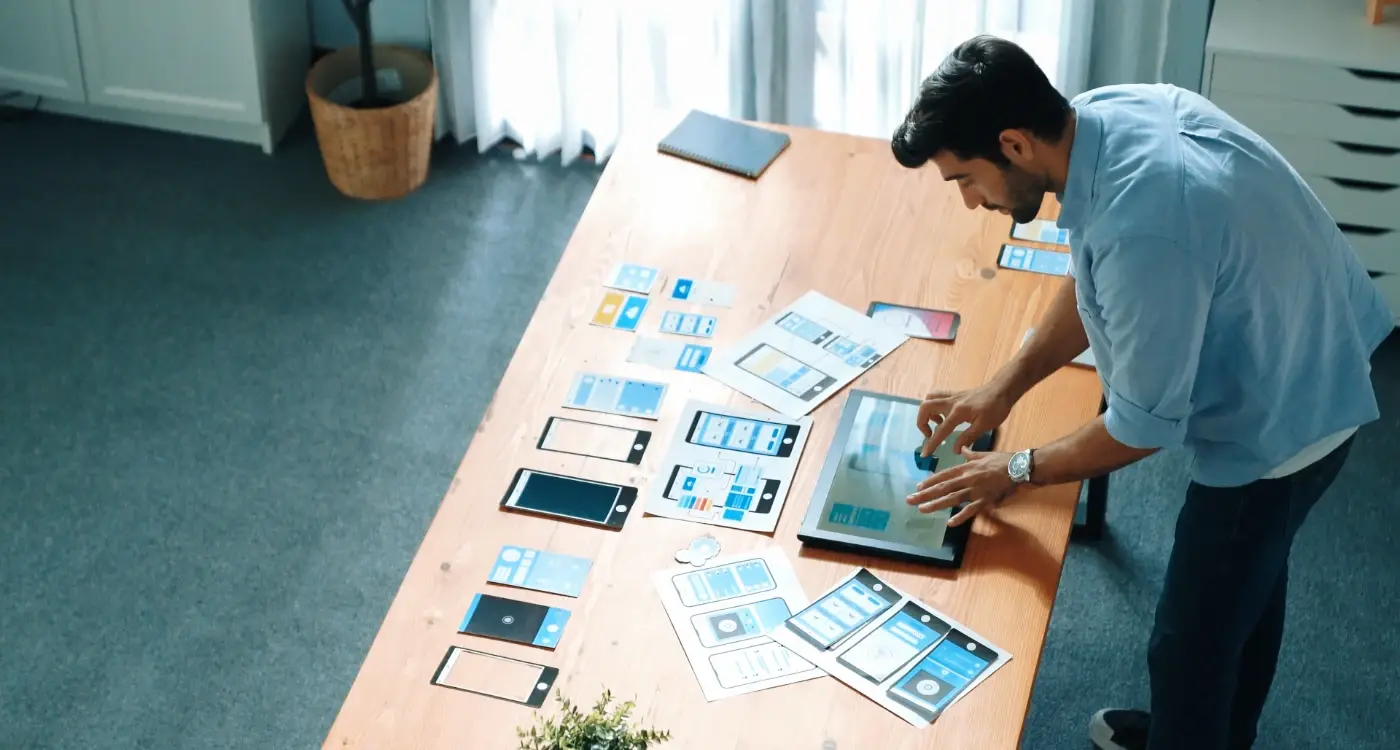What Features Make a Travel App Successful?
Have you ever downloaded a travel app only to delete it before your trip even started? I see this happen all the time—travellers get excited about planning their next adventure, download three or four apps, then end up using just one. The question is: what makes that one app special enough to keep?
After eight years of building mobile apps, I can tell you that successful travel apps aren't just about pretty interfaces or clever marketing. They're about solving real problems that travellers face every single day. The difference between an app that gets deleted and one that becomes part of someone's travel routine comes down to which features actually work when people need them most.
The travel tech industry is packed with apps that promise everything but deliver very little. Some focus too much on flashy animations; others try to cram every possible feature into one place. But the apps that achieve real market success? They understand something simple: travellers need tools that work reliably, save time, and reduce stress.
The best travel apps don't just digitise existing processes—they solve problems that travellers didn't even know they had
Throughout this guide, we'll explore the specific features that separate successful travel apps from the ones gathering digital dust. From core user experience elements to smart personalisation systems, we'll break down what actually drives engagement and keeps users coming back. This isn't about copying what everyone else is doing—it's about understanding why certain features work and how they fit together to create something genuinely useful for travellers.
Core User Experience Features That Drive Engagement
When I look at travel apps that actually get used—not just downloaded once and forgotten—there's always a clear pattern. The successful ones nail the basics before they worry about anything fancy. People don't want to fight with an app when they're trying to book a holiday or find their way around a new city.
The search function is where most travel apps live or die. Users need to find flights, hotels, or restaurants quickly without having to tap through endless menus. A good search lets people filter by price, location, dates, and ratings all on one screen. The results should load fast and show the most relevant options first—not alphabetically or by who paid the most for advertising.
Simple Navigation That Makes Sense
Navigation might sound boring, but it's the foundation of everything else. Your main features should be no more than two taps away from the home screen. I've seen too many apps that hide their booking system behind multiple menu layers, then wonder why nobody completes a purchase.
Visual Content That Actually Helps
Photos and maps aren't just nice to have—they're what help people make decisions. Hotel rooms, restaurant dishes, and tourist attractions need high-quality images that load quickly. Interactive maps should let users zoom in to street level and see nearby transport links or attractions.
The checkout process deserves special attention because this is where you either make money or lose customers. Keep forms short, save user details for next time, and always show the total price upfront. Nobody likes surprise fees at the last minute, and they definitely won't use your app again if you pull that trick on them. This is exactly why UI design is crucial to your mobile app's success—every interface element needs to guide users smoothly through their journey.
Booking and Payment Systems That Convert
Getting people to actually book through your travel app is where the magic happens—or where everything falls apart. I've seen beautifully designed apps with terrible conversion rates because the booking flow was confusing or the payment process scared users away. The difference between a good booking system and a great one often comes down to removing friction at every possible step.
Your booking flow should feel like a conversation, not an interrogation. Start by asking for the minimum information needed to show relevant options. Flight dates, destination, number of passengers—keep it simple. Save the meal preferences and seat selections for later in the process when users are more committed.
Payment Options That Build Trust
Modern travellers expect choice when it comes to paying. Your app needs to support multiple payment methods without making the checkout process feel overwhelming. Here's what successful travel apps typically offer:
- Credit and debit cards (Visa, Mastercard, Amex)
- Digital wallets (Apple Pay, Google Pay, PayPal)
- Buy now, pay later services (Klarna, Clearpay)
- Bank transfers for larger bookings
- Stored payment methods for returning users
Always show security badges and SSL certificates near your payment forms. Trust symbols can increase conversion rates by up to 30% because people need to feel safe when entering their card details.
Smart Booking Features
Price alerts and flexible date searches aren't just nice-to-have features anymore—they're expected. Users want to know if prices drop after they've made a booking, and they want to see alternative dates if it saves them money. The booking process should also handle group bookings smoothly and offer clear cancellation policies upfront. Nobody likes nasty surprises when they're trying to change their travel plans.
Smart Personalisation and Recommendation Features
Travel apps that truly succeed are the ones that feel like they know you personally. And I don't mean in a creepy way—more like that helpful friend who remembers you hate early morning flights and always suggests restaurants with vegetarian options. Building smart personalisation into your travel app isn't just nice to have anymore; it's what separates the apps people delete after one use from the ones they keep coming back to.
The magic happens when your app learns from user behaviour and preferences without making them fill out endless forms. Think about how users interact with your app: which destinations they browse, what price ranges they select, whether they book luxury hotels or budget hostels. All of this data becomes incredibly valuable for creating personalised experiences that enhance customer engagement and drive long-term loyalty.
Key Personalisation Features That Actually Work
- Destination recommendations based on previous searches and bookings
- Price alerts for specific routes or hotels they've viewed
- Customised travel guides featuring activities matching their interests
- Smart filters that remember their preferred amenities and travel style
- Personalised home screen showing relevant deals and suggestions
The tricky bit is getting the balance right—you want to be helpful without being overwhelming. Nobody wants to open a travel app and see fifty different recommendations. Start simple with basic preferences like budget range and travel style, then gradually build up your understanding of each user over time.
Making Recommendations Feel Natural
The best recommendation engines don't feel like algorithms at all. They surface suggestions at the right moments—perhaps showing nearby restaurant recommendations when someone's viewing hotel details, or suggesting activities that complement their booked accommodation. Machine learning helps here, but you don't need fancy AI to get started. Even basic rule-based personalisation can make your app feel much more intelligent and user-friendly than generic alternatives.
Social Features and Community Building
When I look at travel apps that really take off, there's almost always a strong social element. People love sharing their adventures—it's human nature. The most successful travel apps understand this and build their platforms around community connection rather than treating social features as an afterthought.
User-generated content is the backbone of any thriving travel community. Photo sharing, reviews, and travel stories create authentic content that resonates far more than polished marketing materials. When users can upload pictures of their meals in Bangkok or write honest reviews about that quirky hotel in Edinburgh, they're doing your marketing for you. This content becomes invaluable for other travellers who are planning similar trips.
Building Real Connections
The magic happens when users start connecting with each other. Travel buddy matching, local meetups, and shared itinerary features transform your app from a simple booking tool into a social platform. Solo travellers particularly value these connections—being able to find like-minded people in unfamiliar places can make or break their experience. If you're considering adding these features, you might want to explore how to build social features that let users share experiences and connect meaningfully.
Social features aren't just nice-to-have additions; they're what keep users coming back long after their trip ends
Gamification That Works
Travel naturally lends itself to gamification. Check-in systems, travel badges, and destination challenges tap into our competitive nature while encouraging exploration. When users can collect stamps for visiting different countries or earn points for writing helpful reviews, they become more engaged with your platform. The key is making these features feel organic rather than forced—they should enhance the travel experience, not complicate it.
Smart travel apps also leverage social proof effectively. Showing how many people have visited a destination or highlighting trending locations creates FOMO that drives bookings. When users see their friends checking in from exotic locations, it often sparks their own travel planning journey. However, it's important to use social proof ethically without manipulation to maintain trust and authentic user experiences.
Offline Capabilities and Performance Optimisation
Nothing kills the travel experience quite like a slow app that crashes when you need it most. I've lost count of how many times I've seen brilliant travel apps fail because they couldn't handle poor network connections or took forever to load basic information. When you're standing in a foreign airport trying to find your gate, the last thing you want is a spinning wheel of doom.
The reality is that travellers often find themselves in places with patchy internet—remote destinations, underground stations, or simply areas with overloaded networks. Your app needs to work regardless. This means storing key information locally on the device so users can access their bookings, maps, and itineraries even when offline. Flight details, hotel confirmations, and saved locations should all be available without an internet connection.
Smart Caching Strategies
The secret lies in intelligent caching—storing the right information at the right time. When users view their upcoming trips, your app should quietly download all the relevant details in the background. Maps for their destination, transport schedules, and even restaurant recommendations should be ready before they need them. This proactive approach transforms the user experience from frustrating to seamless.
Optimising for Speed
Performance isn't just about offline access; it's about speed when you are connected too. Images need to be compressed properly, data requests should be minimal, and the interface must respond instantly to user interactions. Loading times that seem acceptable on your office WiFi become painfully slow on a 3G connection in rural Italy. Testing your app under real-world network conditions—not just perfect laboratory settings—will reveal performance bottlenecks that could drive users away before they even experience what your app can do.
Integration with External Services and APIs
Travel apps don't work in isolation—they need to connect with the outside world to be truly useful. When we talk about integration with external services and APIs, we're talking about the invisible connections that make your app smart and helpful. These integrations are what turn a basic app into a powerful travel companion.
The most successful travel apps pull information from multiple sources to create a complete picture for their users. Flight data comes from airline APIs, hotel prices from booking platforms, weather information from meteorological services, and maps from navigation providers. Without these connections, you'd have a pretty empty app that doesn't offer much value.
Critical API Integrations for Travel Success
Getting the right integrations isn't just about adding features—it's about choosing the ones that directly impact market success. The travel tech landscape moves quickly, and the apps that win are those that can adapt and connect seamlessly. When building social elements into your app, you'll need to consider which social media APIs to integrate for sharing and community features.
- Flight and transport APIs for real-time schedules and pricing
- Accommodation booking systems for inventory and rates
- Payment gateways for secure transactions
- Mapping and navigation services for location-based features
- Weather APIs for travel planning
- Currency conversion services for international travellers
- Social media APIs for sharing and reviews
Always have backup API providers for critical features. If your main flight data provider goes down during peak booking season, you need alternatives ready to go.
Making Integrations Work Smoothly
The key to successful API integration is making it invisible to users. They shouldn't know or care that your app is pulling data from six different sources—they just want accurate, up-to-date information quickly. This means handling failures gracefully, caching data when possible, and always having a plan B when services go offline. Your approach should focus on ensuring your app developers offer true value to customers through seamless, reliable integrations.
Conclusion
Building a successful travel app isn't about cramming in every feature you can think of—it's about understanding what your users actually need when they're planning trips, booking flights, or exploring new places. The most successful travel apps get the basics right first: they load quickly, work offline when needed, and make booking straightforward without any nasty surprises at checkout.
What really sets apart the winners from the also-rans is how well they balance functionality with simplicity. Your users don't want to spend ages learning how to use your app; they want to get from "I need a hotel" to "booked and confirmed" as smoothly as possible. Smart personalisation helps here—showing relevant suggestions based on past behaviour rather than bombarding everyone with the same generic offers.
The social side of travel apps often gets overlooked, but it shouldn't. People love sharing their experiences and getting recommendations from others who've been there before. Building in ways for users to connect, review, and share makes your app stickier and more valuable.
Integration with external services—maps, payment systems, airline APIs—can make or break the user experience. Nobody wants to constantly switch between apps when they're trying to plan a trip. The more you can handle within your own app, the better.
At the end of the day, successful travel apps solve real problems for real people. Focus on doing a few things brilliantly rather than many things poorly, and you'll be on the right track.
Share this
Subscribe To Our Learning Centre
You May Also Like
These Related Guides

What Are the Key Steps to Building Adaptive App Interfaces?

How Do I Handle Cancellations and Refunds in My Travel App?



